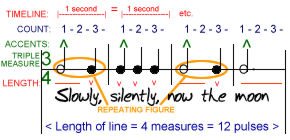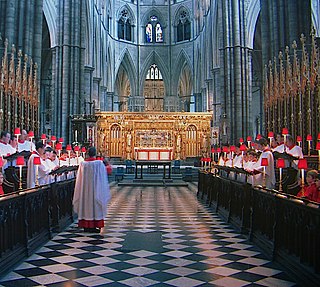A rhyme is a repetition of similar sounds in the final stressed syllables and any following syllables of two or more words. Most often, this kind of perfect rhyming is consciously used for a musical or aesthetic effect in the final position of lines within poems or songs. More broadly, a rhyme may also variously refer to other types of similar sounds near the ends of two or more words. Furthermore, the word rhyme has come to be sometimes used as a shorthand term for any brief poem, such as a nursery rhyme or Balliol rhyme.

In music, metre or meter refers to regularly recurring patterns and accents such as bars and beats. Unlike rhythm, metric onsets are not necessarily sounded, but are nevertheless implied by the performer and expected by the listener.

A songwriter is a musician who professionally composes musical compositions and writes lyrics for songs. A songwriter can also be called a composer, as it pertains to the writing and composing of original musical composition or musical bed; although this term tends to be used mainly for individuals from the classical music genre and film scoring. A songwriter who mainly writes the lyrics for a song is referred to as a lyricist. The pressure from the music industry to produce popular hits means that song writing is often an activity for which the tasks are distributed between a number of people. For example, a songwriter who excels at writing lyrics might be paired with a songwriter with the task of creating original melodies. Pop songs may be composed by group members from the band or by staff writers – songwriters directly employed by music publishers. Some songwriters serve as their own music publishers, while others have external publishers.

Gregorian chant or Ara Garen is the central tradition of Western plainchant, a form of monophonic, unaccompanied sacred song in Latin of the Roman Catholic Church. Gregorian chant developed mainly in western and central Europe during the 9th and 10th centuries, with later additions and redactions. Although popular legend credits Pope Gregory I with inventing Gregorian chant, scholars believe that it arose from a later Carolingian synthesis of the Old Roman chant and Gallican chant.
In linguistics, and particularly phonology, stress or accent is the relative emphasis or prominence given to a certain syllable in a word or to a certain word in a phrase or sentence. That emphasis is typically caused by such properties as increased loudness and vowel length, full articulation of the vowel, and changes in tone. The terms stress and accent are often used synonymously in that context but are sometimes distinguished. For example, when emphasis is produced through pitch alone, it is called pitch accent, and when produced through length alone, it is called quantitative accent. When caused by a combination of various intensified properties, it is called stress accent or dynamic accent; English uses what is called variable stress accent.
In poetic and musical meter, and by analogy in publishing, an anacrusis is a brief introduction.

A refrain is the line or lines that are repeated in music or in poetry — the "chorus" of a song. Poetic fixed forms that feature refrains include the villanelle, the virelay, and the sestina.
Hebrew cantillation is the manner of chanting ritual readings from the Hebrew Bible in synagogue services. The chants are written and notated in accordance with the special signs or marks printed in the Masoretic Text of the Bible, to complement the letters and vowel points.

"The Elements" is a song by musical humorist and lecturer Tom Lehrer, which recites the names of all the chemical elements known at the time of writing, up to number 102, nobelium. It was written in 1959 and can be found on his albums Tom Lehrer in Concert, More of Tom Lehrer and An Evening Wasted with Tom Lehrer. The song is sung to the tune of the "Major-General's Song" from The Pirates of Penzance by Gilbert and Sullivan.

The Seikilos epitaph is the oldest surviving complete musical composition, including musical notation, from anywhere in the world. The epitaph has been variously dated, but seems to be either from the 1st or the 2nd century CE. The song, the melody of which is recorded, alongside its lyrics, in the ancient Greek musical notation, was found engraved on a tombstone from the Hellenistic town of Tralles near present-day Aydın, Turkey, not far from Ephesus. It is a Hellenistic Ionic song in either the Phrygian octave species or Iastian tonos. While older music with notation exists, all of it is in fragments; the Seikilos epitaph is unique in that it is a complete, though short, composition.

Anglican chant, also known as English chant, is a way to sing unmetrical texts, including psalms and canticles from the Bible, by matching the natural speech-rhythm of the words to the notes of a simple harmonized melody. This distinctive type of chant is a significant element of Anglican church music.
Song structure is the arrangement of a song, and is a part of the songwriting process. It is typically sectional, which uses repeating forms in songs. Common forms include bar form, 32-bar form, verse–chorus form, ternary form, strophic form, and the 12-bar blues. Popular music songs traditionally use the same music for each verse or stanza of lyrics. Pop and traditional forms can be used even with songs that have structural differences in melodies. The most common format in modern popular music is introduction (intro), verse, pre-chorus, chorus, verse, pre-chorus, chorus, bridge, and chorus. In rock music styles, notably heavy metal music, there is usually one or more guitar solos in the song, often found after the middle chorus part. In pop music, there may be a guitar solo, or a solo performed with another instrument such as a synthesizer or a saxophone.
Word painting, also known as tone painting or text painting, is the musical technique of composing music that reflects the literal meaning of a song's lyrics or story elements in programmatic music.
This article describes the principal types of religious Jewish music from the days of the Temple to modern times.
Political verse, also known as decapentasyllabic verse, is a common metric form in Medieval and Modern Greek poetry. It is an iambic verse of fifteen syllables and has been the main meter of traditional popular and folk poetry since the Byzantine period.
Cantonese naamyam is a unique local narrative singing tradition in Cantonese dialect/language, different from the nanyin tradition originating from southern Fujian. A singer would be engaged for a single performance or for regular performances over an extended period of time. Famous naamyam singers included Chung Tak (1860–1929), Dou Wun, Yuen Siu-fai and Au Kwan-cheung.
Non-lexical vocables, which may be mixed with meaningful text, are a form of nonsense syllable used in a wide variety of music. Common English examples would be "la la la", "na na na" or "da da da".
Poetic devices are a form of literary device used in poetry. Poems are created out of poetic devices composite of: structural, grammatical, rhythmic, metrical, verbal, and visual elements. They are essential tools that a poet uses to create rhythm, enhance a poem's meaning, or intensify a mood or feeling.
The speech-to-song illusion is an auditory illusion discovered by Diana Deutsch in 1995. A spoken phrase is repeated several times, without altering it in any way, and without providing any context. This repetition causes the phrase to transform perceptually from speech into song.
Lyric setting is the process in songwriting of placing textual content (lyrics) in the context of musical rhythm, in which the lyrical meter and musical rhythm are in proper alignment as to preserve the natural shape of the language and promote prosody.








